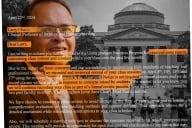You have /5 articles left.
Sign up for a free account or log in.
The message from the White House was loud, clear and footnoted last week: Colleges aren’t doing enough to combat sexual assault on campus and dozens may be out of compliance with federal law.
But the 23-page report, “Not Alone,” also handed out high praise to three universities that will “lead by example” to pinpoint how colleges can improve their sexual assault knowledge, policies and responses. Researchers at University of New Hampshire, University of Texas at Austin and Johns Hopkins University will build on proven records of sexual assault research and launch studies over the next year to help fulfill the White House’s goals.
University of New Hampshire
One of the most important lessons New Hampshire researchers have learned after designing sexual assault education programs is that college students are “at the peak of their narcissism,” said Sharyn J. Potter, an associate professor of sociology and co-director of Prevention Innovations Center.
That means when the New Hampshire group a social marketing program to increase awareness about sexual violence and bystander intervention, customization is key. The researchers have pushed for colleges to move past one-size-fits-all methods, instead tailoring the images and situations to students on specific campuses.
“Students get hung up on the little things, and say, ‘No one would drink that kind of beer here,’ and the larger prevention message fades,” Potter said.
The eight-year-old Prevention Innovations center, made up of a dozen New Hampshire researchers across several disciplines, is known as a national leader for sexual assault prevention. Nearly 300 colleges use Prevention Innovations’ bystander intervention programs, which teaches students ways to step in, such as halting party-goers acting like predators through unconventional tactics such as spilling a drink on the guy or turning off the music as a distraction.
New Hampshire’s attention to the issue, which is also focused by the university’s Sexual Harassment and Rape Prevention Program, crystallized after a 1987 gang rape on the Durham, N.H. campus in which students did nothing to stop the attack.
With White House prodding, the center will now try to identify the best ways to get students to remember campus sexual violence policies – whether colleges should teach them about the regulations online, in residence halls or in lecture halls.
Potter said few colleges support their sexual assault education programming with evidence about how effective it is, and it “is not uncommon for it to be 15 minutes in orientation where students are learning everything and being inundated, so just to talk to them during sexual violence in those two days isn’t effective.”
Still, funding is hard to come by. The center has mostly been bolstered by a million-dollar grant from the Centers for Disease Control and Prevention seven years ago, but is trying to figure out how to pay for the relatively low-cost White House project. With more money, the center could turn its bystander intervention program into a video game or smartphone app, Potter said.
“What we’ve learned from our research is we’re lucky enough to have these students for four to five years so we could change the message as students go through the years,” Potter said. “We just can’t deliver the message once, we have to deliver it in different formats, different ways.”
University of Texas at Austin
Universities have been under a microscope for how their police forces and administrators respond to sexual assault allegations. In preparing for her research, Noël Busch-Armendariz, director of Texas’ Institute on Domestic Violence and Sexual Assault, said she has found that “people really want to do the right thing.”
Many just don’t know how to respond well, especially when sexual assault stereotypes pervade and officials often assume college students don’t know their accused rapists.
“When we have non-stranger sexual assault, things get thornier for law enforcement to figure out. That was the big impetus for the White House to bring us into the conversation,” Busch-Armendariz said.
The institute will take its national research on interpersonal violence and launch an assessment of campus police forces and sexual assault response teams to gauge their training practices, how they treat victims and how many sexual violence reports are filed per student.
The group published a toolkit last fall to help police talk to adult victims of non-stranger sexual assault, which recommends officers say statements like “I know reporting a sexual assault is hard. It took a lot of courage for you to make this call.”
“We really need to help law enforcement shift from investigations that looks at a focus of victim behavior that looks at a focus of offender behavior,” Busch-Armendariz said.
Johns Hopkins University
To add to the research on non-stranger sexual assaults, Johns Hopkins nursing professor Jacqueline Campbell will study her own campus. Campbell and several other researchers will use surveys, interviews and apps with students at Johns Hopkins over the next year to get more evidence on issues of consent and lesbian, gay, bisexual and transgender sexual assault.
In particular, Campbell said the research will fill in two major information gaps college officials face: knowing how many students are raped in off-campus residences and how many males face sexual violence. The study, which will cost Johns Hopkins about $100,000, will also try to find out how campus health centers can better treat victims of sexual violence.
Campbell, who has studied intimate partner violence for more than three decades, said sexual assault research will gain momentum with the White House’s focus. “So often, when a victim reports the alleged perpetrator, it becomes a he-said, she-said or he-said, he-said. If we did a better job in documenting those injuries we would have an additional source around consent,” she said.








